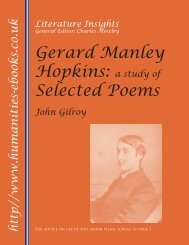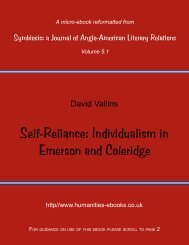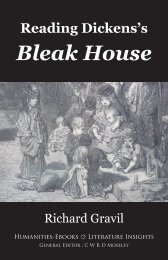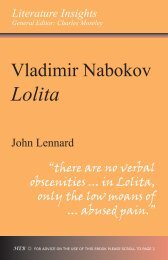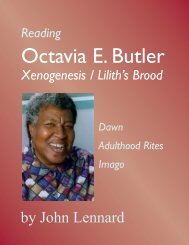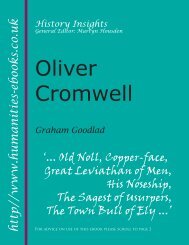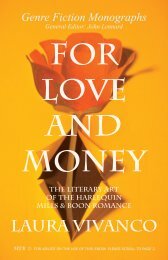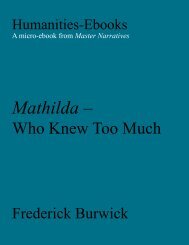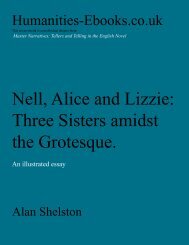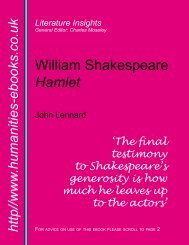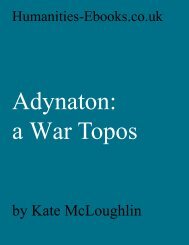The Coleridge Connection - Humanities-Ebooks
The Coleridge Connection - Humanities-Ebooks
The Coleridge Connection - Humanities-Ebooks
Create successful ePaper yourself
Turn your PDF publications into a flip-book with our unique Google optimized e-Paper software.
<strong>The</strong><br />
<strong>Coleridge</strong><br />
<strong>Connection</strong><br />
Essays for Thomas McFarland<br />
edited by<br />
Richard Gravil<br />
& Molly Lefebure<br />
digitized by <strong>Humanities</strong>-<strong>Ebooks</strong>
Is this sample what you are looking for?<br />
If so, please browse our lists<br />
or look for different formats at:<br />
http://www.humanities-ebooks.co.uk<br />
or buy this PDF book<br />
HERE<br />
About <strong>Humanities</strong> <strong>Ebooks</strong><br />
<strong>Humanities</strong>-<strong>Ebooks</strong> is an an authors’ co-operative, not a commercial publisher.<br />
Our aim is to produce inexpensive, high quality <strong>Ebooks</strong>, and to pass the maximum<br />
possible proportion of the purchase price to their authors.<br />
Almost all our titles are available in Kindle format, though for academic books<br />
and those with complex layout the PDF is almost invariably superior.<br />
All our titles can be ordered by libaries through Ebrary, EBSCO and MyiLibrary.<br />
Paperback versions of many of our titles can be reached via the book descriptions<br />
on our website.
<strong>The</strong> <strong>Coleridge</strong> <strong>Connection</strong>:<br />
Essays for Thomas McFarland<br />
edited by Richard Gravil and Molly Lefebure<br />
Tirril: <strong>Humanities</strong>-<strong>Ebooks</strong>, 2007
Contents<br />
Table of Abbreviations<br />
1. Richard Gravil, Introduction and Orientation<br />
Part One: <strong>The</strong> Sometime Jacobin?<br />
2. Ian Wylie, <strong>Coleridge</strong> and the Lunaticks<br />
3 Nicola Trott, <strong>The</strong> <strong>Coleridge</strong> Circle and the ‘Answer to Godwin’<br />
4 Nicholas Roe, <strong>Coleridge</strong> and John <strong>The</strong>lwall: the Road to Nether Stowey<br />
Part Two: Friend and Ventriloquist<br />
5 Molly Lefebure, Humphry Davy: Philosophic Alchemist<br />
6 Grevel Lindop, Lamb, Hazlitt and De Quincey<br />
7 Tim Fulford, <strong>Coleridge</strong> and J. H. Green: <strong>The</strong> Anatomy of Beauty<br />
Part Three: <strong>The</strong> German <strong>Connection</strong><br />
8 James Engell, <strong>Coleridge</strong> and German Idealism: First Postulates, Final Causes<br />
9 Frederick Burwick, <strong>Coleridge</strong> and Schelling on Mimesis<br />
10 E. S. Shaffer, <strong>The</strong> Hermeneutic Community: <strong>Coleridge</strong> and Schleiermacher<br />
Part Four: <strong>The</strong> American <strong>Connection</strong><br />
11 Anthony John Harding, <strong>Coleridge</strong> and Transcendentalism<br />
12 Jonathan Bate, dgar Edgar Allan Poe: A Debt Repaid<br />
Part Five: Sage and Evangelist<br />
13 H. W. Piper, <strong>Coleridge</strong> and the Unitarian Consensus<br />
14 Robert Barth SJ, <strong>Coleridge</strong> and the Church of England<br />
15 John Beer, Transatlantic and Scottish <strong>Connection</strong>s: Uncollected Records<br />
Select Bibliography: Revised and Updated<br />
Search Terms
6<br />
List of Abbreviations<br />
AR<br />
BL<br />
BLS<br />
Bate<br />
CC<br />
CI<br />
CL<br />
CM<br />
CN<br />
C&S<br />
DQW<br />
DLife<br />
DNB<br />
D Works<br />
ELH<br />
Engell<br />
EOT<br />
EY<br />
Friend<br />
Fruman<br />
HWorks<br />
JEGP<br />
S. T. <strong>Coleridge</strong>, Aids to Reflection (London: Taylor & Hessey, 1825).<br />
S. T. <strong>Coleridge</strong>, Biographia Literaria, ed. J. Engell and W. Jackson Bate, CC<br />
vii (1983), 2 vols.<br />
S. T. <strong>Coleridge</strong>, Biographia Literaria, ed. J. Shawcross (Oxford: Clarendon<br />
Press, 1907), 2 vols.<br />
Walter Jackson Bate, <strong>Coleridge</strong> (New York & London: Macmillan, 1968).<br />
<strong>The</strong> Collected Works of Samuel Taylor <strong>Coleridge</strong>, Bollingen Series LXXV<br />
(London and Princeton: Routledge & Kegan Paul and Princeton University<br />
Press, 1969-2005).<br />
<strong>Coleridge</strong>'s Imagination: Essays in Memory of PeteLaver, ed. Richard<br />
Gravil, Lucy Newlyn, Nicholas Roe (Cambridge: Cambridge University<br />
Press, 1985).<br />
<strong>The</strong> Collected Letters of Samuel Taylor <strong>Coleridge</strong>, ed. E. L. Griggs (Oxford:<br />
Clarendon Press, 1956-71), 6 vols.<br />
S. T. <strong>Coleridge</strong>: Marginalia, ed. George Whalley, CC xii (1980-) 6 vols.<br />
<strong>The</strong> Notebooks of Samuel Taylor <strong>Coleridge</strong>, ed. Kathleen Coburn<br />
(Princeton: Princeton University Press, 1957-73), 3 vols. Volume 1, entries<br />
1-1842; volume 2, 1843-3231; volume 3, 3232-4504.<br />
S. T. <strong>Coleridge</strong>, On the Constitution of Church and State, According to the<br />
Idea of Each, ed. J. Colmer, CC x (1976).<br />
Collected Works of Thomas De Quincey, ed. David Masson (Edinburgh: A.<br />
C. Black, 1889-90), 14 vols.<br />
J. A. Paris, <strong>The</strong> Life of Sir Humphry Davy, Bart. (London: H. Colburn and R.<br />
Bentley, 1831).<br />
Dictionary of National Biography.<br />
Collected Works of Sir Humphry Davy, Bart., ed. John Davy (London: Smith,<br />
Elder, 1839-40), 9 vols.<br />
English Literary History.<br />
James Engell, <strong>The</strong> Creative Imagination: Enlightenment to Romanticism<br />
(Cambridge, Mass: Harvard University Press, 1981).<br />
S. T. <strong>Coleridge</strong>, Essays on His Times, ed. David V. Erdman, CC m (1978), 3<br />
vols.<br />
<strong>The</strong> Letters of William and Dorothy Wordsworth, ed. E. de Selincourt, <strong>The</strong><br />
Early Years, 1787-1805, 2nd edn rev. C. L. Shaver (Oxford, Clarendon<br />
Press, 1967).<br />
S. T. <strong>Coleridge</strong>, <strong>The</strong> Friend, ed. B. Rooke, CC iv (1969), 2 vols.<br />
Norman Fruman, <strong>The</strong> Damaged Archangel (New York: Braziller, 1971).<br />
<strong>The</strong> Complete Works of William Hazlitt, ed. P. P. Howe (London & Toronto:<br />
J. M. Dent, 1930-4), 21 vols.<br />
Journal of English and Germanic Philology.
7<br />
LambL<br />
LL<br />
Logic<br />
LPR<br />
LR<br />
LS<br />
LW<br />
McFarland, CP<br />
McFarland, FR<br />
McFarland, OI<br />
McFarland, RC<br />
Modiano<br />
MY<br />
NQ<br />
Norton Prelude<br />
Phil Trans<br />
PL<br />
Prelude<br />
PrW<br />
PW<br />
Roe<br />
Sandford<br />
Shaffer<br />
ShC<br />
<strong>The</strong> Letters of Charles and Mary Lamb, ed. E. Marrs (Ithaca and London:<br />
Cornell University Press, 1975-8), 3 vols.<br />
S. T. <strong>Coleridge</strong>, Lectures 1808-1819: on Literature, ed. R.A. Foakes, CC v<br />
(1987), 2 vols.<br />
S. T. <strong>Coleridge</strong>, <strong>The</strong> Logic, ed. J. R. de J. Jackson, CC xm (1981)<br />
S. T. <strong>Coleridge</strong>, Lectures 1795 on Politics and Religion, ed. L. Patton and P.<br />
Mann, CC i (1971).<br />
S. T. <strong>Coleridge</strong>, Literary Remains, ed. H. N. <strong>Coleridge</strong>, in Shedd, vol. 5.<br />
S. T. <strong>Coleridge</strong>, Lay Sermons, ed. R. J. White, CC vi (1972).<br />
<strong>The</strong> Works of Charles and Mary Lamb, ed. E. V. Lucas (London: Methuen,<br />
1903-5), 7 vols.<br />
<strong>Coleridge</strong> and <strong>The</strong> Pantheist Tradition (Oxford: Clarendon Press, 1969).<br />
Romanticism and the Forms of Ruin (Princeton: Princeton University Press,<br />
1981).<br />
Originality and Imagination (Baltimore: Johns Hopkins University Press,<br />
1985).<br />
Romantic Cruxes: <strong>The</strong> English Essayists and the Spirit of the Age (Oxford:<br />
Clarendon Press, 1987).<br />
Raimonda Modiano, <strong>Coleridge</strong> and the Concept of Nature (London:<br />
Macmillan, 1985).<br />
<strong>The</strong> Letters of William and Dorothy Wordsworth, ed. E. de Selincourt, <strong>The</strong><br />
Middle Years, 1806-1817, 2nd edn rev. Mary Moorman (Oxford: Clarendon<br />
Press, 1969).<br />
Notes and Queries.<br />
William Wordsworth, <strong>The</strong> Prelude, 1799,1805,1850, ed. Jonathan<br />
Wordsworth, M. H. Abrams, Stephen Gill (New York and London: W. W.<br />
Norton, 1979).<br />
Philosophical Transactions of the Royal Society.<br />
<strong>The</strong> Philosophical Lectures of Samuel Taylor <strong>Coleridge</strong>, ed. Kathleen<br />
Coburn (London and New York: Pilot Press, 1949).<br />
William Wordsworth, <strong>The</strong> Prelude, ed. E. de Selincourt, 2nd edn, rev. Helen<br />
Darbishire (Oxford: Clarendon Press, 1959).<br />
<strong>The</strong> Prose Works of William Wordsworth, ed. W. J. B. Owen and Jane<br />
Worthington Smyser (Oxford: Clarendon Press, 1974), 3 vols.<br />
<strong>The</strong> Complete Poetical Works of Samuel Taylor <strong>Coleridge</strong>, ed. E. H.<br />
<strong>Coleridge</strong> (Oxford: Clarendon Press, 1912), 2 vols.<br />
Nicholas Roe, Wordsworth and <strong>Coleridge</strong>: the Radical Years (Oxford:<br />
Clarendon Press, 1988).<br />
Margaret E. Sandford, Thomas Poole and His Friends (London: Macmillan,<br />
1888) 2 vols.<br />
E. S. Shaffer, 'Kubla Khan' and '<strong>The</strong> Fall of Jerusalem': the Mythological<br />
School in Biblical Criticism and Secular Literature (Cambridge: Cambridge<br />
University Press, 1981).<br />
<strong>Coleridge</strong>'s Shakespearean Criticism, ed. T. M. Raysor (London: Constable,<br />
1930; rev. edn, London: Dent, 1960), 2 vols.
8<br />
Shedd<br />
SIR<br />
SSW<br />
Sultana<br />
TT<br />
TWC<br />
WPW<br />
Watchman<br />
<strong>The</strong> Complete Works of Samuel Taylor <strong>Coleridge</strong>, ed. W. G. T. Shedd (New<br />
York: Harper, 1853-8) 7 vols.<br />
Studies in Romanticism<br />
F. W. Schelling, Sämmtliche Werke, ed. K. F. A. Schelling (Stuttgart and<br />
Augsburg: Cotta, 1856-61) 14 vols.<br />
New Approaches to <strong>Coleridge</strong>: Biographical and Critical Essays, ed. Donald<br />
Sultana (London: Vision Press, 1981).<br />
Table Talk and Omniana, ed. T. Ashe (London: George Bell, 1888).<br />
<strong>The</strong> Wordsworth Circle.<br />
<strong>The</strong> Poetical Works of William Wordsworth, ed. E. de Selincourt and Helen<br />
Darbishire (Oxford: Clarendon Press, 1940-9), 5 vols.<br />
S. T. <strong>Coleridge</strong>, <strong>The</strong> Watchman, ed. L. Patton, CC ii (1970).
1<br />
Introduction and Orientation<br />
RICHARD GRAVIL<br />
1. THOMAS McFARLAND AND THE COLERIDGE CONNECTION<br />
In his Life of John Sterling Thomas Carlyle delivers this remorseless and brilliant picture<br />
of <strong>Coleridge</strong>’s conversation at Highgate. It is a passage which Thomas McFarland<br />
reads with memorable relish and gusto.<br />
<strong>Coleridge</strong> sat on the brow of Highgate Hill, in those years, looking down on London<br />
and its smoke-tumult, like a sage escaped from the inanity of life’s battle; . . . He was<br />
thought to hold, he alone in England, the key of German and other Transcendentalisms;<br />
knew the sublime secret of believing by ‘the reason’, what ‘the understanding had<br />
been obliged to fling out as incredible. ... I have heard <strong>Coleridge</strong> talk, with eager<br />
musical energy, two stricken hours, his face radiant and moist, and communicate no<br />
meaning whatsoever to any individual or his hearers.… He began anywhere: you put<br />
some question to him, made some suggestive observation: instead of answering this,<br />
or decidedly setting out towards answer of it, he would accumulate formidable apparatus,<br />
logical swim-bladders, transcendental life-preservers and other precautionary<br />
and vehiculatory gear, for setting out.… He had knowledge about many things and<br />
topics, much curious reading; but generally all topics led him, after a pass or two,<br />
into the high seas of theosophic philosophy, the hazy infinitude of Kantian transcendentalism.<br />
… Glorious islets, too, I have seen rise out of the haze; but they were few,<br />
and soon swallowed in the general element again. Balmy, sunny islets, islets of the<br />
blest and the intelligible. …<br />
Thomas McFarland’s intellectual career has latterly revolved around the central<br />
project of clearing the mists from these ‘islets’ and demonstrating their geological<br />
connectedness or reticulation.<br />
McFarland’s contribution to the study of Romanticism is elegant in its design,<br />
monumental in its scholarship and its effects. His monographs include the mas-
<strong>The</strong> <strong>Coleridge</strong> <strong>Connection</strong> 10<br />
sively learned <strong>Coleridge</strong> and the Pantheist Tradition (1969), two influential essays in<br />
Romantic aesthetics, Romanticism and the Forms of Ruin (1981) and the more theoretical<br />
Originality and Imagination (1985), and most recently Romantic Cruxes: the<br />
English Essayists and the Spirit of the Age (1987), which includes a heroic reading of<br />
the life and work of Charles Lamb, and William Wordsworth: Intensity and Achievement<br />
(1992). But in his edition of <strong>Coleridge</strong>’s Opus Maximum for the Collected <strong>Coleridge</strong>,<br />
McFarland undertook to lock into place what will be-in <strong>Coleridge</strong>’s oeuvre as well as<br />
his own—the keystone of the arch, all that exists, formally, of <strong>Coleridge</strong>’s projected<br />
magnum opus, the great labour which overshadowed all his other productions and to<br />
which they were intended to be tributary.<br />
Chapter Six of Romanticism and the Forms of Ruin offered McFarland’s first<br />
appraisal of ‘the psychic economy and cultural meaning’ of <strong>Coleridge</strong>’s magnum<br />
opus. Plans for this work take many forms over many years, but the heart of it is<br />
always consonant with a plan set down in September 1815. <strong>The</strong> work, according to<br />
<strong>Coleridge</strong>’s description, would comprise six treatises. First ‘a philosophical History<br />
of Philosophy and its revolutions’ from Plato through to the post-empiricist revival of<br />
dynamic philosophy. Second, ‘a system of Logic’. Third, a treatise of ‘the Dynamic or<br />
Constructive Philosophy’, preparatory to the fourth treatise ‘a detailed Commentary on<br />
the Gospel of St John’. <strong>The</strong> fifth treatise would deal with ‘the Pantheists and Mystics;<br />
with the lives of Giordano Bruno, Jacob Behmen, George Fox and Benedict Spinoza’<br />
(those whose work, though negating true Christianity, contributed in <strong>Coleridge</strong>’s<br />
own experience to keeping alive the heart in the head). <strong>The</strong> last would make biographical<br />
amends for <strong>Coleridge</strong>’s own heretical phase, dealing with ‘the Causes &<br />
Consequences of modern Unitarianism’ (CL, iv, 589-90).<br />
<strong>The</strong> new edition of the Opus Maximum opens up all of <strong>Coleridge</strong>’s published<br />
oeuvre, as well as the astonishing notebooks, for enriched re-reading. <strong>The</strong> task of<br />
relating <strong>Coleridge</strong>’s notes and fragments to the central core of his existential and<br />
intellectual design, required an editor who had read all that <strong>Coleridge</strong> read, and rethought<br />
step by step what <strong>Coleridge</strong> thought. <strong>The</strong> present volume of essays (completed<br />
in 1990) was dedicated to Thomas McFarland as one of the very few, among<br />
the successive generations of <strong>Coleridge</strong> scholars, to whom such a momentous task<br />
could properly have been committed, and it was offered as a libation to cheer this<br />
great labour upon its way. As this electronic ‘reprint’ of the festschrift appears, the<br />
first collection of essays on the Opus Maximum has recently been published (edited<br />
by Jeffrey Barbeau), just in time to be included in the revised bibliography.
<strong>The</strong> <strong>Coleridge</strong> <strong>Connection</strong> 11<br />
<strong>The</strong> <strong>Coleridge</strong> <strong>Connection</strong> explores what McFarland calls the symbiotic nature of<br />
<strong>Coleridge</strong>’s friendship and collaborations. <strong>Coleridge</strong>’s biography is to a large degree<br />
a history of his friendships, his talent for inspiring others, and his dependencies.<br />
Throughout his life he chose friends of great distinction in their own spheres: Lamb,<br />
Poole, Southey, <strong>The</strong>lwall, Davy, Gillman, Green and Sterling, and in each case there<br />
is a symbiotic element. <strong>The</strong> mythology of his career begins (apart from the notorious<br />
interlude as Silas Tomkyn Comberbache, trooper of dragoons) with his share in the<br />
Pantisocracy project, and for many contributors to this book Pantisocracy is a fitting<br />
symbol for the <strong>Coleridge</strong> <strong>Connection</strong>: a lifelong <strong>Coleridge</strong>-selected Pantisocracy of<br />
minds, amorphous, anarchistic in the Godwinian sense, and remarkably devoid—<br />
Sara <strong>Coleridge</strong> suggested (in her edition of her father’s Biographia Literaria)—of<br />
property boundaries in matters of thought. <strong>The</strong> ideal intellectual community in which<br />
<strong>Coleridge</strong> was enrolled, does of course extend through time. This book, however, is<br />
largely concerned not with ‘influences’, but with contemporary connections: with<br />
what <strong>Coleridge</strong> gave and found in his many creative friendships, and with his role as<br />
interpreter and critic of some of his German contemporaries.<br />
2. THE SOMETIME JACOBIN? COLERIDGE IN THE NINETIES<br />
I therefore go, and join head, heart, and hand,<br />
Active and firm, to fight the bloodless fight<br />
Of Science, Freedom, and the Truth in Christ.<br />
In the early 1790s it was generally agreed in respectable dissenting circles that the<br />
end of the world—or, more accurately, the beginning of Christ’s thousand-year reign<br />
on earth—was nigh. What form it might take, and whether the millennium would<br />
be inward or public, cataclysmic or gradualist, was a matter of opinion. To the men<br />
of science considered in Ian Wylie’s essay, and to the Unitarians appraised by H. W.<br />
Piper later in the book, the age of universal equality was just around the corner: <strong>The</strong><br />
Lamb of God hath opened the fifth seal’, <strong>Coleridge</strong> opined in Religious Musings.<br />
Thirty years later in the late 1820s, as John Beer reminds us at the end of this book,<br />
rumblings of Apocalypse could again be heard in a largely Caledonian outbreak of<br />
‘speaking in tongues’.<br />
Ian Wylie opens the collection with an illuminating account of <strong>Coleridge</strong>’s relations<br />
to the self-styled ‘Lunaticks’ and their sons, offering a glimpse of the intimate<br />
association between <strong>Coleridge</strong> and science, or natural philosophy, a connection which
<strong>The</strong> <strong>Coleridge</strong> <strong>Connection</strong> 12<br />
is further explored by Molly Lefebure and Tim Fulford later in the book. His essay<br />
calls our attention to the significant presence of Joseph Priestley, Erasmus Darwin<br />
and Benjamin Franklin as presiding genii of <strong>Coleridge</strong>’s Religious Musings, and the<br />
extent to which major Lunar Society figures were enmeshed with <strong>Coleridge</strong>’s Bristol<br />
circle. He also sheds fascinating new light on the plausibility—one might even say<br />
Necessity—of the famous Pantisocracy project, which project recurs in several subsequent<br />
essays as a symbol of the ideal community to which <strong>Coleridge</strong>’s thought in<br />
all its phases seems to aspire.<br />
<strong>The</strong> second and third essays in the collection, Nicola Trott’s on <strong>Coleridge</strong>’s socalled<br />
‘Answer to Godwin’ and Nicholas Roe’s treatment of the <strong>The</strong>lwall connection,<br />
offer methodologically contrasting approaches to the matter of <strong>Coleridge</strong>’s apostasy.<br />
<strong>The</strong> weakness of the presiding guru of the age, in the eyes of dissenting radicals<br />
who had not lost their faith, was his atheism, and Nicola Trott’s essay demonstrates<br />
how <strong>Coleridge</strong>’s contestation with Godwin and his adherents entwines Hartleyan<br />
and Unitarian traditions of thought in the search for an antidote to Political Justice.<br />
<strong>The</strong> essential platform for a riposte to Godwin’s chilling disinterestedness had to<br />
be an alternative theory of benevolence, in which <strong>Coleridge</strong> unites Priestley, Frend<br />
and Dyer. ‘General Benevolence’, argues Conciones ad Populum, ‘is begotten and<br />
rendered permanent by social and domestic affections.… <strong>The</strong> intensity of private<br />
attachments encourages, not prevents, universal Benevolence.’ And in developing his<br />
response, <strong>Coleridge</strong> is also laying the foundations for the part of the Recluse project<br />
that Wordsworth did find it possible to realize. <strong>The</strong> Wordsworthian poetry of the<br />
affections, it is suggested, is founded in <strong>Coleridge</strong>’s ‘millennium of love—the fraternizing<br />
revolution of Religious Musings’.<br />
Nicholas Roe recovers what he calls ‘the banished history’ of one of <strong>Coleridge</strong>’s<br />
early friendships. John <strong>The</strong>lwall, orator, agitator, poet, elocutionist is one of the most<br />
attractive figures of the time. He was sufficient of an adept at poetry—in a variety of<br />
fashionable modes, not all of them derivative—to treat with the authors of Lyrical<br />
Ballads as a fellow poet, as well as a fellow democrat. <strong>The</strong> allusion to <strong>The</strong>lwall’s<br />
Welsh address (‘Liswyn farm’) in Wordsworth’s Anecdote for Fathers is a poignant<br />
reminder of this. He was au fait with much in contemporary intellectual culture and, as<br />
Molly Lefebure’s essay shows, he fed <strong>Coleridge</strong>’s interest in science at an early date.<br />
<strong>The</strong>re can be little doubt also that his remarkable prose poem <strong>The</strong> Peripatetic (1793)<br />
contributes both to the themes of Lyrical Ballads and to the scope and compass, if<br />
not of <strong>Coleridge</strong>’s Platonic scheme for ‘<strong>The</strong> Recluse’, then at least of Wordsworth’s<br />
earliest published instalment of that project, <strong>The</strong> Excursion. <strong>Coleridge</strong>’s denial of him
<strong>The</strong> <strong>Coleridge</strong> <strong>Connection</strong> 13<br />
is, by corollary, one of the least attractive features of his biography. Nicholas Roe’s<br />
essay on ‘the road to Nether Stowey’ attempts to set the record straight.<br />
This matter of <strong>Coleridge</strong>’s alleged apostasy, and indeed the matter of his relations<br />
to Godwin, presiding guru of secular radicalism, may require some introductory<br />
comment. Macaulay’s judgement on Wordsworth’s Prelude, when published<br />
in 1850, that it revealed its author as having been ‘to the last degree Jacobinical,<br />
indeed socialist’ is not the kind of remark anyone felt tempted to make of Biographia<br />
Literaria, when published in 1817. Rather, that work seems to have been designed<br />
to create the impression that <strong>Coleridge</strong> had always been remote from faction and<br />
dissent. John <strong>The</strong>lwall and Robert Southey, of course, knew better. <strong>The</strong>ir responses<br />
to <strong>Coleridge</strong>’s apostatic recreation of the 1790s—Southey declaring that if <strong>Coleridge</strong><br />
was not a Jacobin ‘I wonder who the devil was’, and <strong>The</strong>lwall recollecting <strong>Coleridge</strong><br />
as ‘a man of blood’—are detailed in Nicholas Roe’s essay.<br />
Despite his immense output of lectures and essays (the Lectures on Politics and<br />
Religion (1795), the ten numbers of <strong>The</strong> Watchman (1796), the contributions in<br />
<strong>The</strong> Morning Post and <strong>The</strong> Courier from 1797 onwards) and the evidence of the<br />
Notebooks and the Collected Letters, recovery of <strong>Coleridge</strong>’s politics in the 1790s<br />
is by no means as easy as it might seem. Two readings seem to be possible. <strong>The</strong> first<br />
is that <strong>Coleridge</strong> was in fact deeply committed to political opposition, at least until<br />
1798 when—as he tells his brother—he has ‘snapped my squeaking baby-trumpet of<br />
Sedition’, and that what he was committed to was, in the common sense of the term<br />
at that time, a broadly ‘Jacobin’ or Democratic view. <strong>The</strong> other is that even in his<br />
earliest recorded public utterances, the magnificent Conciones ad Populum (1795),<br />
<strong>Coleridge</strong> is clearly engaged in staking out a conservative political philosophy, not<br />
greatly different from that of Church and State (1829), even while his rhetoric takes<br />
on the lurid colouring of the day. That rhetoric, especially when contemplating the<br />
hypocrisies of the Church, betrayed as he once put it to Sir George and Lady Beaumont<br />
‘a disposition to catch fire, from the very rapidity of my own motion’, and may well<br />
have coloured <strong>The</strong>lwall’s recollection of its substance.<br />
<strong>Coleridge</strong>’s work throughout 1795 and 1796 in the Bristol lectures and <strong>The</strong><br />
Watchman is unified by a sustained critique of the ‘atheism’ of many leading radicals.<br />
Thomas Paine rarely receives a favourable mention. Still more surprisingly, the<br />
unworldly Godwin is privately presented in the role of chief regent of the grovelling<br />
sensualists, a ‘pandar to sensuality and vice’. <strong>Coleridge</strong>’s most sustained work of<br />
1795, the Lectures on Revealed Religion, is impelled by the same impulse that led<br />
him in 1796 to contemplate a book on Godwin, comparing ‘the two systems—his &
<strong>The</strong> <strong>Coleridge</strong> <strong>Connection</strong> 14<br />
Jesus’s’ (CL, i, 293). While this remark recognises the importance of Godwin, it also<br />
casts him as the Antichrist. <strong>Coleridge</strong> of course shared Godwin’s critique of the evils<br />
of property, and his conviction of the need for social progress to arise through gradual<br />
illumination, until the values of a ‘deeply principled minority’ become that of the<br />
whole community. In some respects <strong>Coleridge</strong>’s critique of impetuous political action,<br />
and his despairing remark in France: An Ode that nothing good can come from forms<br />
of government, may sound Godwinian, but much of what seems most Godwinian<br />
might, as Lewis Patton and Peter Mann have argued (in their extensive introduction<br />
to the 1795 lectures), derive more directly from Priestley and the Unitarians.<br />
<strong>Coleridge</strong>, at this date, saw Christianity as essentially egalitarian. He therefore<br />
respected in Godwin what was compatible with the mores of the early Christians, and<br />
shared Godwin’s suspicions of political action (as Nicola Trott points out, <strong>Coleridge</strong>’s<br />
position in 1795 is that ‘“whatever is just in Godwin is more forcibly recommended<br />
in the Gospel, and whatever is new is absurd”’). He suspected from the first, however,<br />
that Godwin’s system must be ineffectual since it lacked any grasp of the importance of<br />
private attachments and their necessary connection to the social feelings. Nevertheless,<br />
Godwin and <strong>Coleridge</strong> became close enough in 1800 and later for Godwin to be<br />
the recipient of some of <strong>Coleridge</strong>’s most revealing letters, for instance about the<br />
extinction of his poetic self. In 1800 we find <strong>Coleridge</strong> demanding that Godwin should<br />
not ‘cease to appear as a bold moral thinker’, and exhorting him to ‘write a book on<br />
the power of words … in short ... to philosophise Home Tooke’s System’. Evidently<br />
<strong>Coleridge</strong> thought highly enough of Godwin at this time to suppose him capable of<br />
solving ‘the great Questions’ relating to language and thought (<strong>Coleridge</strong> was always<br />
capable of imagining that his friends were capable of philosophical originality). One<br />
can see the influence of Godwin’s anarchism in <strong>Coleridge</strong>’s disappointed retreat<br />
from political optimism, his thoughts upon education and his animadversions against<br />
political associations—above all in <strong>Coleridge</strong>’s progress from millenarian oratory<br />
towards sober-sided clerisy. And indubitably, in return, though it is a matter of some<br />
irony that it should be so, <strong>Coleridge</strong> infused into Godwin a species of Pantheism.<br />
3. THE RECLUSE PARADIGM<br />
That <strong>Coleridge</strong>’s friendship with the Wordsworths is exceptional, in so far as it<br />
involved one of the most celebrated partnerships in literary history, need not blind<br />
one to the possibility that the nature of his friendship is also in some measure paradigmatic.<br />
With Dorothy Wordsworth the friendship is relatively untroubled: on the
<strong>The</strong> <strong>Coleridge</strong> <strong>Connection</strong> 15<br />
whole <strong>Coleridge</strong> did not regard women as competitors, even when he admired them.<br />
He raids her journals with as much impunity as did her brother, and is not averse,<br />
when stuck for an image or the mot juste, to asking Dorothy ‘for a word’. Dorothy<br />
undoubtedly praised more unstintingly and was more easily influenced. As anima she<br />
is the necessary completion of the trinity.<br />
With her brother, the friendship was more problematical. <strong>The</strong>re is a marked curve,<br />
from initial dependency and self abasing adulation of ‘the Giant Wordsworth’, to<br />
resentment of the complacency of the adulated friend, and this curve <strong>Coleridge</strong> had<br />
travelled before. A letter to Southey in 1795, as the Pantisocracy project collapses in<br />
recriminations, prefigures in two of its motifs the Wordsworth relationship. At the<br />
end of the letter <strong>Coleridge</strong> alludes to what has been: ‘I did not only venerate you for<br />
your own Virtues, I prized you as the Sheet Anchor of mine’. Near the beginning of<br />
the letter, however, he peremptorily informs Southey (who has latterly demonstrated<br />
an obdurate concern with property and rank, incompatible with the communal ideals<br />
of Pantisocracy) that ‘You are lost to me, because you are lost to virtue’. Less than<br />
presciently, in view of Southey’s later role as provider for <strong>Coleridge</strong>’s wife and children,<br />
he adds that ‘this will probably be the last time I shall have occasion to address<br />
you’. He diagnoses in Southey what he will later find in Wordsworth: ‘you relapsed:<br />
your manners became cold and gloomy’, he complains, and Southey is detected in a<br />
tendency to make ‘Self an undiverging Center’.<br />
<strong>The</strong>re is by now a considerable literature dealing with the Wordsworth/<strong>Coleridge</strong><br />
relationship and its many fascinations. <strong>The</strong> second section of this book is designed<br />
to complement rather than to add to that literature, though Elinor Shaffer’s essay<br />
in Part Three appraises the matter in relation to Biographia Literaria. A brief comment<br />
here, may serve to focus, in a resumptive way, the central creative friendship<br />
of <strong>Coleridge</strong>’s life. Critical endeavour in recent years has identified a number of primary<br />
issues. One is the nature of the Lyrical Ballads collaboration: was the volume<br />
intended to contain two kinds of poems (as proclaimed in Biographia), or one as<br />
suggested elsewhere? On this question depends the further question as to whether,<br />
in the compositional history of that work, we see a case of Wordsworth’s naturalism<br />
wilfully marginalising the <strong>Coleridge</strong>an poetry of the supernatural. Associated with<br />
this problem is the question of the theoretical differences between the two poets. A<br />
‘radical difference’ is recognised by <strong>Coleridge</strong> as early as 1803, but it is most clearly<br />
expressed in <strong>Coleridge</strong>’s misrepresentation, in Biographia, of Wordsworth’s views on<br />
‘poetic diction’, and his surprisingly conservative critique of Wordsworth’s practice<br />
and precepts from Aristotelian and Johnsonian premises. Recent work—particularly
<strong>The</strong> <strong>Coleridge</strong> <strong>Connection</strong> 16<br />
Lucy Newlyn’s Echo and Allusion (1986)—has illuminated the fascinating question<br />
of <strong>Coleridge</strong>’s presence in <strong>The</strong> Prelude as addressee, invoked again and again, yet as<br />
one who arrives too late in Wordsworth’s biography to have any significant influence<br />
upon his character or his opinions.<br />
This last leads us to the primary question, which has to do with the great work,<br />
which, as all agree, <strong>Coleridge</strong> foisted upon Wordsworth, the writing of <strong>The</strong> Recluse.<br />
It is not however in the inception of the work that <strong>Coleridge</strong>’s influence is most interesting<br />
but in its development. <strong>The</strong> debate about the relative merits of the ‘1805’ and<br />
‘1850’ texts of <strong>The</strong> Prelude is—curiously—conducted almost without reference to<br />
the primary determinant of their evolution. For although <strong>Coleridge</strong> in 1804, in his<br />
letter to Sharp, was confident that Wordsworth would in effect be writing ‘the first<br />
and finest philosophical poem’ if he could simply achieve ‘a faithful transcript of. . .<br />
his own most habitual feelings and modes of seeing and hearing’ (and although the<br />
poetic accolade in ‘To William Wordsworth’ appears to concur with this supposition),<br />
there is clearly a conflict between this model and those recollected in 1815 and<br />
1832, which suppose that writing a philosophical poem would involve refuting ‘the<br />
sandy Sophisms of Locke’ while demonstrating ‘a manifest Scheme of Redemption’.<br />
Writing to Wordsworth in May 1815 he makes it abundantly clear that <strong>The</strong> Prelude<br />
was not in <strong>Coleridge</strong>’s mature view a philosophical poem: ‘This I considered as <strong>The</strong><br />
EXCURSION’, he says of <strong>The</strong> Prelude, whereas in <strong>The</strong> Recluse ‘I had … anticipated<br />
… that …you were to begin a Philosophical Poem’.<br />
This is not the place to demonstrate in detail the degrees to which the revisions of<br />
<strong>The</strong> Prelude are compelled by Wordsworth’s need to transform the written poem into<br />
an effective substitute for the unwriteable Recluse and the disappointing Excursion.<br />
What needs to be examined (and one may hope that Norman Fruman will one day<br />
flesh out the many brilliant hints he has hitherto given in this direction) is the extent to<br />
which Wordsworth’s thirty year revisionary exercise is driven by the desire to make<br />
‘the poem to <strong>Coleridge</strong>’ more acceptable in the sight of one who was, if not necessarily<br />
il miglior fabbro, then certainly ‘the onlie begetter’. In modifying the work from<br />
‘the poem on my own mind’, to a work on the human spirit, Wordsworth also makes<br />
<strong>The</strong> Prelude seem less the work of a mind on the move and rather more the testament<br />
of one ‘whose mind is made up’: the meditation ab intra modulates info a discourse<br />
ab extra. <strong>The</strong> style—while often sharper and more powerful—too frequently abandons<br />
the homely phrase for greater elegance. One single revision, in which 1805 has<br />
the mind ‘breathed upon by a sensation’ where 1850 decides that it was ‘smitten by<br />
a sublime idea’, seems characteristic of a shift from an authentic expression of an
<strong>The</strong> <strong>Coleridge</strong> <strong>Connection</strong> 17<br />
animist variant upon Empiricism toward a ventriloquized, and less honest, case for<br />
Idealism. <strong>The</strong> net effect—as well as creating a work of subtler articulation and more<br />
epic argument—is to make the poem conform more fully to the <strong>Coleridge</strong>an prospectus<br />
for <strong>The</strong> Recluse.<br />
4. FRIEND AND VENTRILOQUIST<br />
Wordsworth, however, was not the only one who found that his attempts at creative<br />
self-definition would be bound up with the fulfilment of <strong>Coleridge</strong>’s labours. <strong>The</strong><br />
three essays in Part Two of this book consider the various ways in which <strong>Coleridge</strong><br />
impinged upon the creative lives of five other friends, and they upon him, in a complex<br />
pattern of ventriloquism and cross-insemination. <strong>The</strong>se friends belong to distinct<br />
periods in his life. Charles Lamb was of course a friend of <strong>Coleridge</strong>’s from<br />
schooldays. <strong>The</strong> friendships with Sir Humphry Davy, William Hazlitt and Thomas De<br />
Quincey belong to the years of <strong>Coleridge</strong>’s greatest poetic productivity. <strong>The</strong> fifth, J.<br />
H. Green, first met <strong>Coleridge</strong> in Highgate in 1817, and became—like James Gillman<br />
and John Sterling—one of the conduits through whom <strong>Coleridge</strong>’s mind coursed into<br />
Victorian culture.<br />
<strong>The</strong> extent to which Lamb, Hazlitt and De Quincey learn from, and contribute to,<br />
<strong>Coleridge</strong>’s labours, and see themselves—with varying degrees of compensatory criticism—working<br />
under cover of ‘the greater Ajax’, is considered by Grevel Lindop. His<br />
essay will augment the admiration many already feel for Lamb (<strong>Coleridge</strong>’s oldest and<br />
closest friend) as one of the most incisive and sympathetic of critics, by demonstrating<br />
the rhetorical skill with which he steered <strong>Coleridge</strong>’s development towards the style<br />
of the ‘conversation poems’. In Hazlitt’s case, the extent of their later estrangement<br />
(<strong>Coleridge</strong>’s epistolary remarks upon Hazlitt are as virulent as Hazlitt’s attacks upon<br />
him are vehement) tends to obscure from us how profound was <strong>Coleridge</strong>’s impact<br />
upon Hazlitt’s early development. Lindop enables one to see Hazlitt’s later criticism<br />
of <strong>Coleridge</strong> as correspondent to his early idealisation, and as expressive of Hazlitt’s<br />
frustration at finding himself in the position—as he saw it—of pursuing the task<br />
of communicating truths which the greater figure had abandoned. Hazlitt comes to<br />
identify in <strong>Coleridge</strong> a desire ‘not to be understood’. His complaint about with wilful<br />
obscurity of Christabel may, in the light of <strong>Coleridge</strong>’s later anxieties about finishing<br />
his synthetic magnum opus lest it lead his readers to question the self-sufficiency of<br />
revelation, strike one as having a certain authority and prescience.<br />
Where Hazlitt and Lamb can be seen respectively as one-time protégé and long-
<strong>The</strong> <strong>Coleridge</strong> <strong>Connection</strong> 18<br />
term partner, Lindop suggests, De Quincey’s relation to <strong>Coleridge</strong> was rather wary<br />
and competitive, intellectual rather than personal. <strong>The</strong> philosophical interests of the<br />
two—as students of ‘the Kantian system’—were closer than was the case with either<br />
Lamb or Hazlitt. <strong>The</strong>re is, on De Quincey’s part at least, a direct literary rivalry, in<br />
which the younger man tries both to outshine and to distance himself from <strong>Coleridge</strong>’s<br />
parallel experiences as opium-addict, using <strong>Coleridge</strong>’s celebrity as a shield, while<br />
advancing against his rival the charge that <strong>Coleridge</strong> lacked the courage of his addictions.<br />
Lindop’s reading of the relationship suggests, too, how De Quincey’s promotion<br />
of <strong>Coleridge</strong> as plagiarist is best seen as part of his dealings with one who, in this<br />
dimension also, was ‘a troublesome twin’.<br />
Molly Lefebure and Tim Fulford turn to <strong>Coleridge</strong>’s closest friends among men<br />
of science, Humphry Davy, chemist, and Joseph Henry Green, anatomist. Davy, who<br />
first met <strong>Coleridge</strong> in Bristol, was close to him in the years of <strong>Coleridge</strong>’s greatest<br />
poetic productivity. Lefebure demonstrates how in the friendship with Humphry Davy<br />
one can observe a man of science fulfilling in a substantial degree, in works as diverse<br />
as Moses and Consolations in Travel, aspects of a <strong>Coleridge</strong>an Recluse project. Her<br />
essay presents a fascinating insight into the way in which the literary and intellectual<br />
pursuits of this myriad-minded man run parallel to those of <strong>Coleridge</strong>. Of all<br />
<strong>Coleridge</strong>’s friends this most poetic and visionary of scientists, ‘Father and Founder<br />
of philosophic Alchemy’ as <strong>Coleridge</strong> would remember him, exercised the most<br />
immediate influence on the direction of <strong>Coleridge</strong>’s own enquiries. It was an earlier<br />
and equally illuminating essay by Molly Lefebure on the relations between <strong>Coleridge</strong><br />
and Davy that led to the conception and design of this collection of essays.<br />
Joseph Henry Green, Professor of Anatomy at the Royal College of Surgeons, is<br />
popularly familiar to literary students mainly because he features in the anatomical<br />
education of John Keats (Green was Demonstrator of Anatomy at Guy’s Hospital<br />
where Keats learned anatomy and physiology) and is mentioned in Keats’s famous<br />
reminiscence of an encounter with <strong>Coleridge</strong> on Hampstead Heath. Green was just<br />
twenty-six when he first met <strong>Coleridge</strong>, in 1817, and at the start of his highly distinguished<br />
medical career (a distinction which owed something to the philosophical<br />
nuances which <strong>Coleridge</strong>’s influence imparted to his anatomical lectures). In later<br />
years, after his retirement from medicine, Green applied himself to a programme of<br />
study almost as ambitious as the youthful Humphry Davy’s in order to prepare himself<br />
for the task of piecing together <strong>Coleridge</strong>’s thought. His Spiritual Philosophy:<br />
Founded upon the Teaching of the Late S. T. <strong>Coleridge</strong> was published posthumously<br />
in 1865. Tim Fulford’s study of the interaction of <strong>Coleridge</strong> and J. H. Green demon-
<strong>The</strong> <strong>Coleridge</strong> <strong>Connection</strong> 19<br />
strates how Green’s distinction as a professor and a lecturer gave <strong>Coleridge</strong> a vicarious<br />
extension to his own lecturing career. Both had studied in Germany, and together<br />
they were able to refine ideas which they had independently derived from those earlier<br />
studies, especially from Kant, Schelling and Solger. Examining this collaborative<br />
revision of shared sources the essay demonstrates the extent of their mutual indebtedness,<br />
and the value of Green’s aesthetics to <strong>Coleridge</strong>’s epistemology.<br />
Fulford’s essay also puts into a fresh context the problem of <strong>Coleridge</strong>’s notorious<br />
‘definitions’ of primary and secondary imagination in the truncated thirteenth chapter<br />
of Biographia. <strong>The</strong>re are many problems to do with <strong>Coleridge</strong>’s definitions. Nothing<br />
said in them seems directly to correspond to Wordsworth’s view of imagination as<br />
‘Reason in her most exalted mood’, or to Shelley’s view of it as ‘the instrument of<br />
moral good’. Although primary imagination is defined as the ‘agent of all human<br />
perception’, the inclusion of the word ‘all’ seems to recognise that some perception is<br />
more perceptive than others. Beauty, as Fulford points out, ‘is first an act of perception’.<br />
So, of course, are wholeness, meaning, and relation. <strong>The</strong> perennial argument<br />
about whether primary imagination gives us merely the world of ‘motor-buses, beefsteaks<br />
and acquaintances’ (in I. A. Richards’s phrase), or also the fresh creation at the<br />
opening of Wordsworth’s <strong>The</strong> Leech-Gatherer, or whether—as some believe—it enables<br />
us to ‘see into the life of things’, is barely soluble in the terms <strong>Coleridge</strong> gives<br />
us. <strong>The</strong> definitions of secondary imagination and fancy seem curiously preoccupied<br />
with the aesthetic, yet when applied to poetry they seem too brief and too tendentious<br />
to be of use as a critical tool. When we are told in Biographia Chapter 22 that<br />
Wordsworth possessed ‘imagination in the highest sense of the word’, we are left to<br />
guess just what that highest sense might be. Clearly <strong>Coleridge</strong> has left us all in the<br />
air. Tim Fulford’s contribution to this debate is to argue that Green’s work offered<br />
‘the only public completion’ of <strong>Coleridge</strong>’s theory of Imagination in aesthetic terms,<br />
and that Green also places this in the context of ‘the imagination’s production of a<br />
moral transcendence.’ What enabled him to do so, of course, is the shared German<br />
connection.<br />
5. THE GERMAN CONNECTION<br />
<strong>Coleridge</strong>’s German connection began with the visit to the ageing poet Klopstock in<br />
September 1798, in which conversation was held in the main through the medium of<br />
Wordsworth’s French. After a period of language study <strong>Coleridge</strong> settled in Göttingen.<br />
This choice was not accidental. English Unitarians were at this time receptive to the
<strong>The</strong> <strong>Coleridge</strong> <strong>Connection</strong> 20<br />
new German sciences, and especially to the new developments in critical exegesis<br />
of the Bible. Thomas Beddoes, who enjoyed a personal reputation in Germany, had<br />
friends in Göttingen. Among them was J. G. Eichhorn, Orientalist and pioneer of<br />
modern biblical criticism, with whose work <strong>Coleridge</strong> was already familiar—through<br />
Beddoes—before he left Bristol. In Göttingen he also attended the physiology lectures<br />
of the famous anthopologist J. F. Blumenbach, and became acquainted with T.<br />
C. Tychsen, the philologist. During this period <strong>Coleridge</strong> conceived the notion of<br />
writing a Life of Lessing (then notorious for the corrosiveness of his own Biblical<br />
researches) from which project Davy later discouraged him. In 1805/6, during his<br />
circuitous return from Malta, he met Wilhelm von Humboldt, and also Ludwig Tieck<br />
with whom a long and productive friendship developed.<br />
In 1828, when he visited Germany again in the company of Wordsworth and Dora,<br />
<strong>Coleridge</strong> was welcomed as a celebrity in his own right, and among those who called<br />
was August Wilhelm Schlegel. In the interim he had of course become notable as a<br />
communicant of German intellectual culture, and in his transmission of the ideas of<br />
Kant, Schelling, Fichte, Tetens, and the Schlegels, had posed for posterity immense<br />
problems regarding the independence and the cogency of his thought in metaphysics<br />
and aesthetics, as well as the degree to which some of his central preoccupations are<br />
determined, or merely enriched, by his acquaintance with German thought. <strong>The</strong> first<br />
of <strong>Coleridge</strong>’s editors to confront these problems was the most brilliant of his own<br />
progeny, Sara <strong>Coleridge</strong>.<br />
Despite his poetic preoccupations with Nature and Imagination, <strong>Coleridge</strong> is<br />
indubitably concerned in the first place and the last place with religion. In this preoccupation<br />
lies the explanation of why it is that ‘the most imaginative of poets’ refuses<br />
to follow German thought uncritically in its most characteristic excesses as regards<br />
Naturphilosophie and the liberty of Imagination. Attracted as he was to the work of<br />
the Naturphilosophen—their search for a holistic explanation of creation, and their<br />
dynamic model of nature, based upon the dialectical principle of polarity, could not<br />
fail to appeal to the <strong>Coleridge</strong> of the Notebooks—he baulked at the anti-Biblical<br />
implications, in Schelling especially, of the self-subsistence of nature, and at the erosion<br />
in their work of any real sense of the separateness of the creator from creation,<br />
or indeed of body and soul.<br />
When, for example, <strong>Coleridge</strong> confuses everyone by writing of primary imagination<br />
in scriptural terms—’<strong>The</strong> primary IMAGINATION I hold to be the living Power<br />
and prime AGENT of all human perception, and as a repetition in the finite mind of<br />
the eternal act of creation in the infinite I AM’—he does so because he wishes to
<strong>The</strong> <strong>Coleridge</strong> <strong>Connection</strong> 21<br />
redeem imagination, as a spiritual faculty, from the implications of infidel theories<br />
of mind. <strong>The</strong> philosophical context of the Biographia definition is <strong>Coleridge</strong>’s first<br />
attempt to synthesise the German ‘dynamic system’ (which he has been gaily plagiarizing)<br />
with the Christian, while continuing his refutation of British empiricism. His<br />
language is designed to establish that imagination is not, as Naturphilosophie might<br />
imply, a simple outgrowth of nature, an eruption in man of nature’s creative principle,<br />
but instead is that characteristic in man which transcends nature, and links him with<br />
God. At the same time, since in <strong>Coleridge</strong>’s view, ‘any system based upon the passivity<br />
of mind must be false’, he makes it abundantly clear that even in such basic perceptual<br />
activity the mind is exercising a creative and self-affirming power (‘I perceive<br />
therefore I exist’). In effect he offers a definition of perceptual activity which—while<br />
not precisely Fichtean—does most impressively call attention to the activity of mind<br />
in constituting its world. That it is not precisely Fichtean is adequately shown by the<br />
insistence that what the mind creates, as it marshalls its disparate data into meaningful<br />
wholes and relationships, is indeed a ‘repetition’ rather than a perverse variation<br />
upon creation. Nature is, in <strong>Coleridge</strong>, a given: neither the Absolute, nor the product<br />
of solipsistic ego-activity. Furthermore, God continues to uphold his creation, so<br />
what we reflect is ‘the eternal act of creation in the infinite I AM’.<br />
<strong>The</strong> question of the degree of coincidence between what <strong>Coleridge</strong> found in German<br />
work, and what he himself brought to the redefinition of these materials, is illuminatingly<br />
explored by James Engell in his comprehensive essay on <strong>Coleridge</strong>’s transmission<br />
and revision of German idealism. <strong>The</strong> essay suggests that not only <strong>Coleridge</strong>’s<br />
ideas about religion, and imagination, but also his contributions to thought about<br />
mimesis and hermeneutics, the subjects of the two subsequent essays, all owed much<br />
to the same foundation, namely his grounding in the principles or first postulates of<br />
German metaphysics. While it is this fresh perspective that will interest the specialist,<br />
Engell’s essay will prove enlightening to readers with little previous exposure<br />
to transcendental idealism. In particular, Engell reminds us that both Schelling and<br />
<strong>Coleridge</strong> were concerned to overturn a materialist philosophy ‘according to which<br />
there can be neither poetry, religion nor love’.<br />
Frederick Burwick contributes an exacting study of the precise use to which<br />
<strong>Coleridge</strong> put the work of Schelling in his discrimination between ‘copy’ and ‘imitation’;<br />
that is, between the unreality, inertia and redundance which we would experience<br />
if art were concerned with ‘copy’ and the mythopoeic activity engaged in<br />
‘imitation’. This aspect of his aesthetic theory is quite as central, Burwick argues, as<br />
the more celebrated distinction between fancy and imagination. Mimetic art has as
<strong>The</strong> <strong>Coleridge</strong> <strong>Connection</strong> 22<br />
its purpose, according to Schelling, the accomplishment of a task which the philosopher<br />
can only contemplate; the revelation of the essential coincidence of mind and<br />
nature. All art, on this definition, is mythological, and an expression of the quest for<br />
reunion. What <strong>Coleridge</strong> makes of Schelling’s formative contribution to this question<br />
of aesthetics is, similarly, the essay suggests, a creative mimesis rather than a<br />
passive imitation: <strong>Coleridge</strong> enriches his extensive appropriations from Schelling,<br />
and derives from Schelling’s premises a very different set of implications, partly as<br />
regards the relation between the infinite ‘I AM’ and the conscious self-affirming will<br />
of the individual artist.<br />
For <strong>Coleridge</strong> the act of reading was above all a matter of entering a relationship<br />
with another mind. Like Kierkegaard he was a natural hermeneut. In the final essay<br />
on <strong>The</strong> German <strong>Connection</strong> E. S. Shaffer contributes a study of <strong>Coleridge</strong> in relation<br />
to the theologian, Friedrich Schleiermacher, a kindred spirit in many ways but particularly<br />
in his extension of hermeneutic methods, hitherto confined to the study of<br />
the Bible and classical texts, to the reading of modern literary—and particularly of<br />
course Romantic—texts. Her essay relates the issue of evolving a general hermeneutic<br />
to the strategy and assumptions of Biographia, which work she sees as ‘a search for<br />
a method’, and as belonging to a genre originated by Giambattista Vico, the nineteenth-century<br />
Neapolitan professor of Rhetoric, whose works are founding texts in<br />
the developing study of the humanities. What others have seen as <strong>Coleridge</strong>’s forensic<br />
dismemberment of Wordsworth’s theory and practice in the course of Biographia,<br />
Shaffer sees as an effort to set Wordsworth within the ‘colloquy of past and present<br />
minds’, a transhistorical community. In <strong>Coleridge</strong>’s allusiveness, and the curiously<br />
‘intertextual’ form of his most characteristic productions—poetic texts either built<br />
upon dialogue or embedded in their own commentaries—Shaffer finds manifestations<br />
of what Bakhtin calls ‘internal heterology’, or a dialogue of styles, avoiding<br />
pure and unmediated authorial discourse. Biographia, ingeniously, is presented as the<br />
aesthetic realisation of the ideal community of Pantisocracy.<br />
6. THE AMERICAN CONNECTION: FROM PANTISOCRACY TO<br />
TRANSCENDENTALISM<br />
<strong>Coleridge</strong>’s American connection began, of course, with the Pantisocracy project in<br />
1794, and stemmed (as lan Wylie points out) from his admiration for the Unitarian<br />
sages who emigrated to the new world as political and religious exiles. It was deepened<br />
in practical terms during his circuitous return from Malta, in 1805-6, when in
<strong>The</strong> <strong>Coleridge</strong> <strong>Connection</strong> 23<br />
Rome he became a friend of Washington Allston (who painted his portrait). In later<br />
years, in the Highgate sanctuary provided by Dr and Mrs Gillman, <strong>Coleridge</strong> was<br />
visited by a procession of American visitors, including, most famously, the writers<br />
James Fenimore Cooper and Washington Irving, Dr William Ennery Channing, the<br />
leader of the American Unitarians, and Ralph Waldo Emerson.<br />
In Part Four of this book Anthony Harding revisits territory on which he has written<br />
with such perspicuity in his study of <strong>Coleridge</strong> and the Inspired Word (1985),<br />
and examines more directly than in his book the matter of <strong>Coleridge</strong>’s relation to<br />
American transcendentalism, and his transatlantic status as an embattled prophet of<br />
romantic individualism, or—to more conservative opinion—a lonely defender of<br />
religious truths. While Fuller, Hedge, Alcott and Thoreau are considered, the heart of<br />
the essay is an examination of Emerson’s role as <strong>Coleridge</strong>’s ‘most original avatar’. It<br />
is something of a historical irony that Emerson should meet <strong>Coleridge</strong> at the moment<br />
when the visitor was relinquishing his remaining interest in dogma, and his host was<br />
wrestling with the doctrine of the Trinity. As Harding reads the encounter, precisely<br />
this dissonance permits and encourages the younger man’s graduation from acolyte to<br />
equal: an equality which will paradoxically permit him to glean more from <strong>Coleridge</strong><br />
after the disappointing visit—and to do so more directly—than he had done before<br />
it. A particular concern of the essay is to discriminate Emersonian ‘Reason’ from<br />
its <strong>Coleridge</strong>an and Kantian counterparts. Another is to distil the peculiar nature of<br />
Emerson’s communicative art. Indirectly, it seems to me, the essay may also suggest,<br />
through a number of its allusions to Wordsworth, as well as some unremarked echoes<br />
of Wordsworthian manuscripts, the intriguing possibility that without <strong>Coleridge</strong> <strong>The</strong><br />
Excursion might have evolved into a more Emersonian work than it already is.<br />
A second figure whose declaration of literary independence is in some degree<br />
qualified by a marked transfusion from <strong>Coleridge</strong> is Edgar Allan Poe. Jonathan Bate’s<br />
chapter reconsiders the question of Poe’s indebtedness to <strong>Coleridge</strong>, taking as his base<br />
text the notorious essay on “<strong>The</strong> Philosophy of Composition’, which he sees as a conscious<br />
inversion of <strong>Coleridge</strong>’s equally notorious stance (in the note to Kubla Khan)<br />
as the mere amanuensis of inspiration. Poe’s curriculum vitae—as supernatural story<br />
teller, critic and theorist, philosophical speculator, author of marginalia, plagiarist and<br />
laudanum taker—is, as Bate points out, oddly parallel to that of <strong>Coleridge</strong>. Each of<br />
these Poes is in some degree indebted to his precursor (as a plagiarist, Bate amusingly<br />
demonstrates, Poe seems to borrow the very manner of his plagiarism from the elder<br />
writer), and these debts have long been catalogued. <strong>The</strong>ir meaning, however, is due<br />
for reappraisal in the light of recent rethinking of the nature of literary influence, and
<strong>The</strong> <strong>Coleridge</strong> <strong>Connection</strong> 24<br />
literary colloquy. Approaching this task through an extended reading of Poe’s early<br />
tale, MS Found in a Bottle, Bate presents the story as not merely a powerful reworking<br />
of <strong>The</strong> Ancient Mariner, but as one which, rightly read, may save the poem from<br />
its more positivist critics.<br />
7. SAGE AND EVANGELIST<br />
<strong>The</strong> final section of this collection is concerned primarily with the religious dimension<br />
of <strong>Coleridge</strong>’s life and work. <strong>The</strong>re can be little doubt that for many readers the<br />
freedom of <strong>Coleridge</strong>’s early work derives from his rebellion against the Established<br />
Church. It certainly gains colour from his conviction that the Church of England is<br />
as corrupt as that of Rome: ‘the mark of Antichrist is on both of them’. For some the<br />
emerging centre of his Highgate preoccupations, the establishment of a philosophical<br />
underpinning of Trinitarian theology, and the exposition of the constitutions and<br />
relative positions of Church and State according to the Idea of each, is a matter so<br />
peripheral to progressive concerns, so essentially defensive, that <strong>Coleridge</strong>’s selfimmersion<br />
in such matters, whatever their success, can only be a matter of regret. For<br />
others, the insights which <strong>Coleridge</strong> gave his acolytes in the Church’s nineteenthcentury<br />
rearguard action—and in particular his role in freeing believers from their<br />
indefensible belief in the literal inspiration of the Bible—are an integral manifestation<br />
of his Romantic vision. Certainly it is this that gives his life its meaning and<br />
its unity. E. S. Shaffer put the matter succinctly in ‘Kubla Khan’ and ‘<strong>The</strong> Pall of<br />
Jerusalem’ (1975): ‘Unitarianism, then, led <strong>Coleridge</strong> directly to the German higher<br />
criticism’ and in turn ‘the mythological school of German higher criticism enabled<br />
him to move away from the immediate reformist concerns of the radicals and towards<br />
a new apologetics that ultimately he would use to transform Anglicanism and make it<br />
viable for another century’.<br />
H. W. Piper, author of <strong>The</strong> Active Universe, examines the rise and fall of <strong>Coleridge</strong><br />
as a Unitarian. Religious Musings, as a synthesis of Unitarian belief, made <strong>Coleridge</strong><br />
persona grata throughout the Unitarian community, which at that time embraced<br />
the most progressive figures in philosophy, science, and manufacturing technology.<br />
Such circles subscribed largely to <strong>The</strong> Watchman. <strong>The</strong> leading dramatis personae<br />
in <strong>Coleridge</strong>’s Unitarian progress are of course William Frend, a Fellow of Jesus,<br />
George Dyer and Thomas Beddoes, and John Prior Estlin, Unitarian minister and<br />
headmaster: it was another Unitarian, Thomas Wedgwood, whose offer of an annuity<br />
would relieve <strong>Coleridge</strong> from the need to enter formally the Unitarian ministry. Piper
<strong>The</strong> <strong>Coleridge</strong> <strong>Connection</strong> 25<br />
argues that Unitarian beliefs underlie the symbology of the major poems throughout<br />
the 1790s, and that his philosophical enquiries in the period between 1800 and 1805<br />
lead him into a phase of ‘negative unitarianism’, rather than to a rejection of it. Not<br />
until the Malta journey did <strong>Coleridge</strong> embrace the Trinitarian faith which he had hitherto<br />
found idolatrous.<br />
Robert Barth, however, sees the Unitarian connection as an aberrant interlude<br />
in <strong>Coleridge</strong>’s central relationship with the Anglican church. By reverting to the<br />
Anglican communion—‘this Catholic and Apostolic Church in England’—<strong>Coleridge</strong><br />
enrolled himself again not merely in a theological tradition but in a congenial tradition<br />
of thought and language, a sensus communis which extends from those great<br />
divines of the sixteenth and seventeenth centuries, Richard Hooker and Jeremy Taylor,<br />
through <strong>Coleridge</strong> himself, to those who would, with him, undertake both to restore<br />
the Church’s declining spirituality and remind it of its social obligations. If Pusey<br />
and Newman are more associated with the former aspect of <strong>Coleridge</strong>’s witness, Dr<br />
Arnold and F. D. Maurice (and, one might add, <strong>Coleridge</strong>’s most concrete legacy to<br />
church and clerisy, his son Derwent) are more concerned with the Church as leavening<br />
agent.<br />
Since this book was first published in 1990 the impact of Robert Weisbuch’s formative<br />
work Atlantic Double-Cross has led to an explosion of transatlantic studies,<br />
and to a deepened appreciation of the role of <strong>Coleridge</strong> in inspiring the thought and<br />
the creative literature of American Transcendentalism. <strong>The</strong> essays by Harding and<br />
Bate, above, have helped to fuel that reassessment, and transatlantic studies provide<br />
one of the major areas of expansion in the bibliography. Further American connections,<br />
and in particular some long-forgotten accounts of <strong>Coleridge</strong> by American visitors<br />
to Highgate in the 1820s, experiencing one of <strong>Coleridge</strong>’s legendary monologic<br />
performances, are the primary concern of John Beer’s essay. One of these records,<br />
published here for the first time, includes a remarkable verbatim note of <strong>Coleridge</strong>’s<br />
ideas on the Trinity, as expounded on 1 August 1829 to John Wheeler, later to become<br />
President of the University of Vermont. Another is an unsympathetic vignette by John<br />
McVickar, who would later make amends in his own edition of Aids to Reflection. In<br />
a fascinating sub-plot, illuminated by McVickar’s account, Beer explores the story of<br />
<strong>Coleridge</strong>’s interest in the Scottish orator, Edward Irving, whose involvement in an<br />
outbreak of ‘speaking with tongues’—sufficiently prevalent at this time to give rise<br />
to fresh speculation about the approach of Apocalypse—led to his dismissal from his<br />
ministry and a trial for heresy.
<strong>The</strong> <strong>Coleridge</strong> <strong>Connection</strong> 26<br />
8. THE CARLYLE CONNECTION<br />
In its brief evocation, via John Sterling and A. H. Hallam, of the Cambridge Apostles,<br />
Beer’s essay alludes also to those contemporaries who experienced what Basil Willey<br />
so poignantly termed, in his essay on Tennyson, ‘that poised uncertainty of the devoutly<br />
inclined agnostic mind’. Sterling himself was an acolyte both of <strong>Coleridge</strong> and of<br />
Carlyle, and represents a sort of synthesis of the two. Looking first to <strong>Coleridge</strong> for<br />
resuscitation of the Church, he ultimately lost patience with his mentor’s caution.<br />
Instead he turned towards a more Emersonian position, stressing divine immanence<br />
where <strong>Coleridge</strong> increasingly stressed transcendence. Unlike Carlyle, however, he<br />
was neither impatient of ideas, nor sceptical of the theological enterprise itself. A<br />
more introspective Carlyle, a more latitudinarian <strong>Coleridge</strong>, Sterling deserves greater<br />
credit than he has received as a harbinger of contemporary theology.<br />
Sterling’s example also reminds us of the extent to which Carlyle is, after all, a<br />
secular version of <strong>Coleridge</strong>. <strong>The</strong>re is much to be said for Emerson’s feeling—when<br />
reading Sartor Resartus—that he ‘had got all that earlier, from <strong>Coleridge</strong>’: it is hard to<br />
imagine a reader who would not feel that from time to time. Among the most thought<br />
provoking aspects of the <strong>Coleridge</strong> connection is the extent to which Sartor can be<br />
read as an attempt to present the <strong>Coleridge</strong>an ‘islets’ without the mist—or rather with<br />
the mist retranslated, as it were, into Teufelsprach, and consciously and rhetorically<br />
deployed, in engaging parody, as backdrop to the islets. Within its broader critique of<br />
Anglo-German Romanticism, Sartor Resartus presents a labour-saving digest of the<br />
essential <strong>Coleridge</strong> designed for rapid infusion into the Victorian drawing room—or<br />
indeed the Victorian novel. Its form entwines the mode of Biographia with that of<br />
Goethe’s Werther: in substance it is a transcendentalised Recluse, or a realised Brook.<br />
Idiosyncratic though its style may be, its major preoccupations are <strong>Coleridge</strong>an.<br />
Carlyle’s is the existential <strong>Coleridge</strong>: one hears him in Teufelsdröck’s urgent question<br />
‘What am I, the thing that can say I” (even if it is presented as a translation of<br />
‘das Wesen das sich ich nennt’); in the theme of the subjectivity of truth (‘feel it in<br />
thy heart ... all else is opinion’); in the work’s haunting anxiety concerning the absenteeship<br />
of God; and above all in its stress upon the duty of unfolding the self, where<br />
<strong>Coleridge</strong> is of course explicitly cited. Both writers are dedicated to the Blake-like<br />
task of reanimating the spiritual form of their country. Carlyle seeks to do so without<br />
subjecting it once more to the sartorial shortcomings of the established church.<br />
<strong>Coleridge</strong>’s genius was equal to any in the nineteenth century: his tragedy, as<br />
Carlyle saw so clearly, if unsympathetically, was religion. From that Cain-like moment
<strong>The</strong> <strong>Coleridge</strong> <strong>Connection</strong> 27<br />
in his childhood, when he almost succeeded in killing his brother (it is described in<br />
one of the autobiographical letters to Tom Poole, October 1797), the sense of sin came<br />
between <strong>Coleridge</strong> and the public realisation of what he seems to have been born to<br />
do—aiding the evolution of a post-Christian sense of the spiritual life. Instead, from<br />
an agnostic standpoint, he seems to have devoted much of his life to combating the<br />
evolution of such a sense. He left Carlyle and Emerson to suggest what a humancentered<br />
mythos might mean, just as he left Hazlitt to represent a continuing sense<br />
of political possibilities. Certainly he stood athwart his age in many respects. Yet<br />
many ideas which <strong>Coleridge</strong> refused to foster have already waned, while many which<br />
he instigated have yet to be properly valued. His work, especially in the infinitely<br />
rewarding notebooks, yields more with every passing year. Our sense of the place of<br />
<strong>Coleridge</strong> in the mind of the nineteenth century—and not least his seminal presence<br />
in the more ordered oeuvres of his friends and critics (oeuvres which often achieved<br />
the status of scholarly editions decades before the Collected <strong>Coleridge</strong> emerged to<br />
demonstrate <strong>Coleridge</strong>’s true stature) continues to grow.
Part 1<br />
<strong>The</strong> Sometime Jacobin?
Is this sample what you are looking for?<br />
If so, please browse our lists<br />
or look for different formats at:<br />
http://www.humanities-ebooks.co.uk<br />
or buy this PDF book<br />
HERE<br />
About <strong>Humanities</strong> <strong>Ebooks</strong><br />
<strong>Humanities</strong>-<strong>Ebooks</strong> is an an authors’ co-operative, not a commercial publisher.<br />
Our aim is to produce inexpensive, high quality <strong>Ebooks</strong>, and to pass the maximum<br />
possible proportion of the purchase price to their authors.<br />
Almost all our titles are available in Kindle format, though for academic books<br />
and those with complex layout the PDF is almost invariably superior.<br />
All our titles can be ordered by libaries through Ebrary, EBSCO and MyiLibrary.<br />
Paperback versions of many of our titles can be reached via the book descriptions<br />
on our website.



